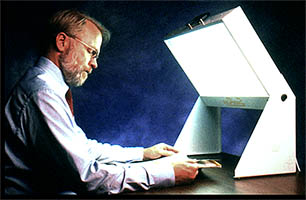

How Bright Light Therapy Helps with Low Mood, Sleep Problems and Jet Lag
Last Revised November 2019


How Bright Light Therapy Helps with Low Mood, Sleep Problems and Jet Lag
By Daniel F. Kripke, M.D.
Last Revised November 2019

A New Theory: How Does Bright Light Work Biologically?
For many decades, dozens of research groups have tried to understand the biology predisposing to depression and mania. There are hundreds of theories. Study of artificial light effects on mood began in the 19th century, and relevant study of circadian abnormalities in depression began with Richter’s work commencing over 80 years ago. The evidence for circadian system involvement has gradually become more and more compelling. My colleagues and I have reviewed some of this background in a long review article that proposed circadian and photoperiodic mechanisms for depression, notably involving the hypothalamic suprachiasmatic nucleus influencing the pars tuberalis (a hypothalamic region at the hypothalamic-pituitary junction.)[88] A PowerPoint graphic presentation offers some animated illustrations.[89] Additional compelling data were published after our 2015 review in the past couple of years.[90]
To simplify, melatonin is a hormone that has regulated seasonal and light responses as early in biological evolution as the single-cell living organisms. Elaborate largely-similar mechanisms to adapt biological responses to the seasons developed in fish, birds, and mammals. In mammals, bright morning light falling on the eyes and stimulating the intrinsically photosensitive retinal ganglion cells leads through a complex system (transmitted through the suprachiasmatic nucleus) to suppressing morning melatonin secretion. If melatonin is not suppressed at dawn, melatonin inhibits a neurochemical chain reaction in pars tuberalis that would have promoted release of active thyroid hormone into the hypothalamus. Accordingly, light at dawn facilitates hypothalamic thyroid hormone actions that increase pituitary gonadotropin hormones and regulate the hypothalamic-pituitary-adrenal cortisol system. In this way, we imagine that hypothalamic thyroid activity, independent of thyroid gland regulation, promotes a normal or elevated mood and prevents depression. This may be the primary mechanism by which bright morning light protects and restores mood.
The timing of a person’s internal body clocks is also a factor. For example, evening people (which depressed people tend to be) spontaneously begin secreting melatonin later in the evening, and their melatonin is elevated later into the morning (see Chapter 6). If evening people arise too late and do not expose themselves to daylight early enough, their morning melatonin may suppress hypothalamic levels of active thyroid hormone and lead to depression. The longer nights of winter may also be a factor in winter depression, because dawn may come too late to properly suppress morning melatonin, since a depressed person arising at their normal time in winter might be up long before dawn. It follows that bright light administered soon after a depressed person has been arising (or a little before), by suppressing the morning melatonin, would reduce depression. Further, in accordance with the phase response curve described in Chapter 6, by advancing the times when melatonin secretion spontaneously commences and terminates, morning bright light may correct the delayed phases of those suffering depressions.
It is possible that excessive morning bright light may excessively advance the time when melatonin secretion is terminated in the early morning, leading to an excess of hypothalamic active thyroid hormone. Since it is well-known that excessive peripheral thyroid hormone can cause manic symptoms, it would not be surprising if morning bright light, when producing excessive phase advances, were a factor predisposing to mania caused by excessive hypothalamic thyroid hormone.
It may be more difficult to reconcile the pars tuberalis theory with depression related to advanced sleep phase symptoms. One possibility would be that early sleep leads to an early onset of transcription of the gene EYA3, which seems to be transcribed for only about 12 hours per day. EYA3 is part of the pathway triggering pars tuberalis induction of active thyroid hormone, but EYA3 transcription is suppressed nocturnally by melatonin. It appears that normally some EYA3 is transcribed in the morning after melatonin secretion terminates, leading to adequate hypothalamic active thyroid concentrations. However, if the circadian pattern of EYA3 transcription and its termination became more advanced than melatonin secretion is advanced, melatonin might excessively suppress morning EYA3 transcription, resulting in inadequate active thyroid hormone in the hypothalamus. This might explain how phase advances of a special sort lead to depression.
These theories of the biology of depression might begin to explain the well-documented associations between depression and delayed or advanced sleep phase syndromes and their responses to bright light.
Endnote for Chapter 9
88. Kripke DF, Elliott JA, Welsh DK, Youngstedt SD. Photoperiodic and circadian bifurcation theories of depression and mania. F1000Res. 2015![]()
![]() ;4:107. [return]
;4:107. [return]
89. Kripke, DF. The beginning of light therapy. 12-21-2016. [return]
90. Jones SE, Lane JM, Wood AR, et al. Genome-wide association analyses of chronotype in 697,828 individuals provides insights into circadian rhythms. Nat Commun 2019![]()
![]() ;10(1):343; Kripke, D. F. When our body clocks run late: does it make us depressed? Ann Transl Med
;10(1):343; Kripke, D. F. When our body clocks run late: does it make us depressed? Ann Transl Med![]()
![]() 4(9), 178. 2016.[return]
4(9), 178. 2016.[return]
Table of Contents
Brighten Your Life, in all its formats, including this ebook, copyright ©1997-2019 by Daniel F. Kripke, M.D. All rights reserved.